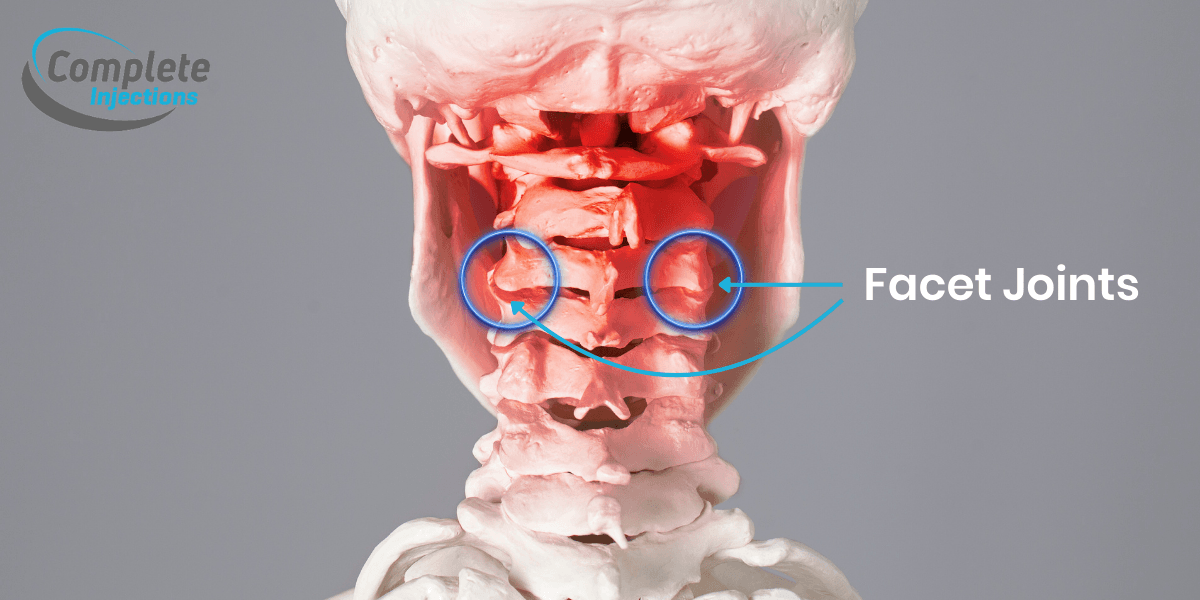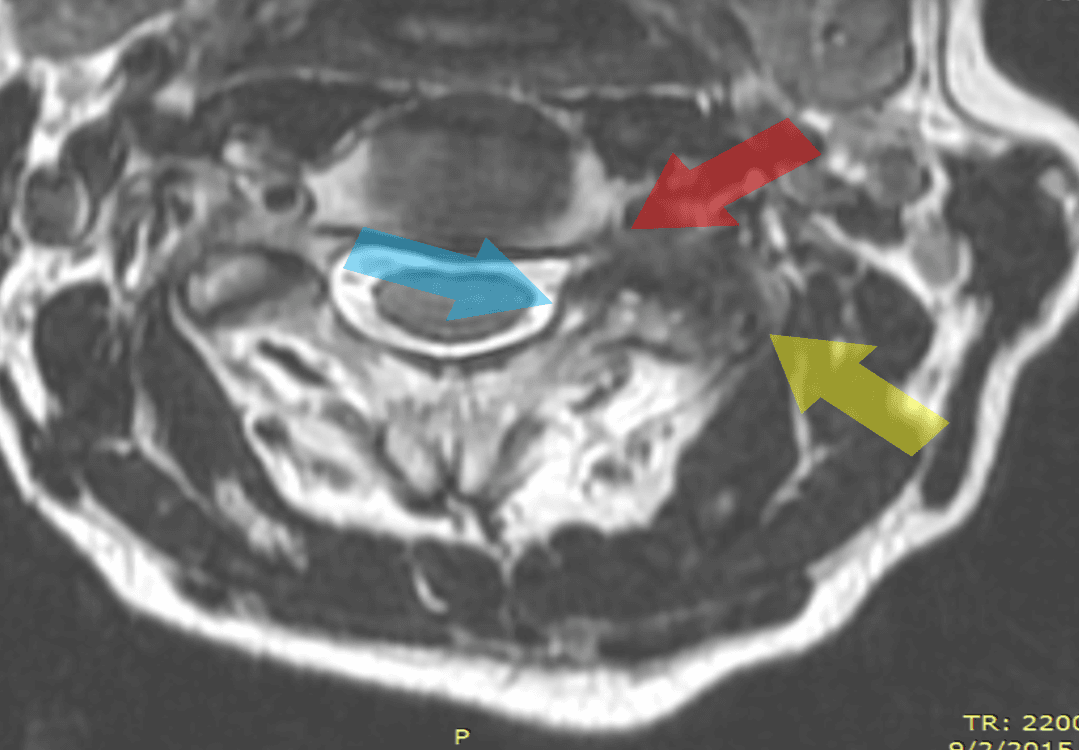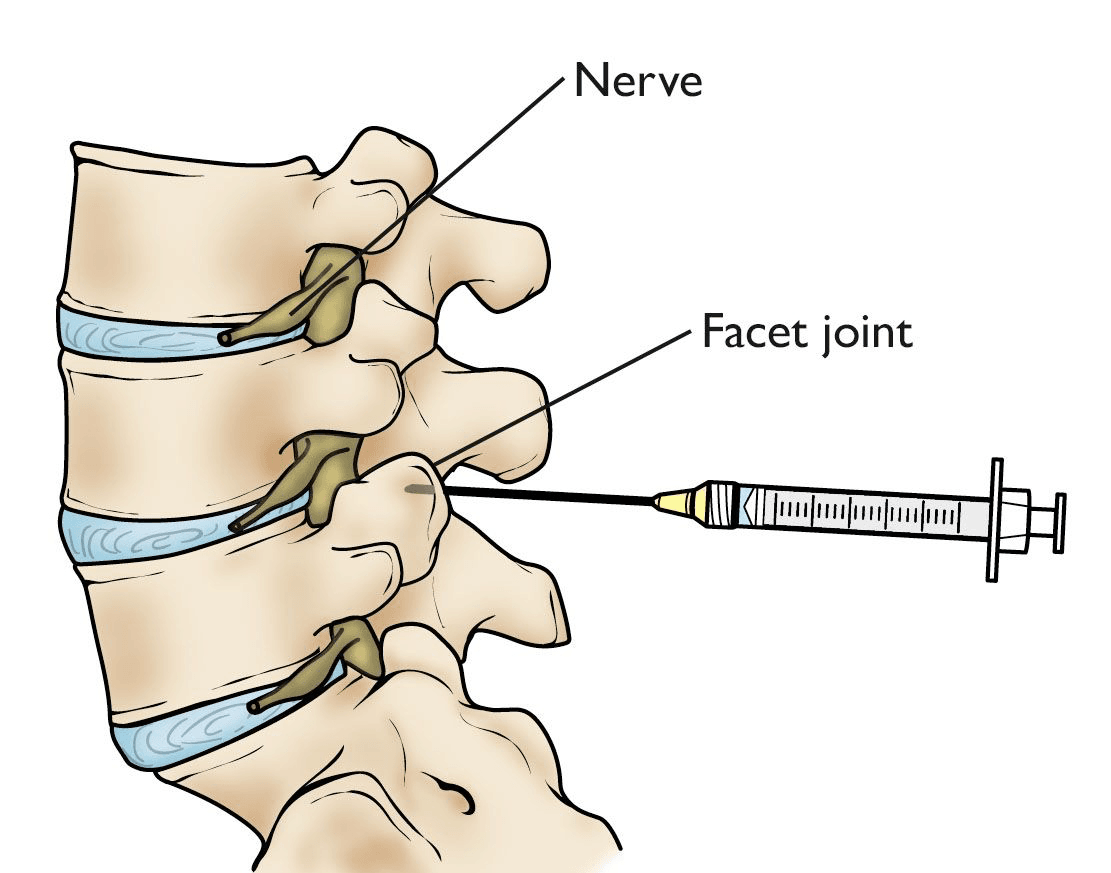What is cervical facet joint pain?
Cervical facet joint pain, also known as facet joint syndrome, is one of the most common causes of neck pain. These small joints, located along the back of the spine, can become inflamed, injured, or subject to ‘wear and tear’(normal ageing process) over time.
Cervical facet joint pain can be particularly debilitating because it often radiates to other areas, such as the shoulders and upper back. Other common symptoms may include headaches, muscle spasms, and sensations of tingling or numbness in the arms or hands. Although facet joint syndrome can develop in any part of the spine, it is especially prevalent in the cervical (neck) and lumbar (lower back) regions.
For many people, conservative treatment such as hands-on physiotherapy, exercise rehabilitation and pain relief medication is highly effective. However there are a number of patients who do not respond as well or as quickly to these methods. For those who are experiencing longer term, high levels of pain and decreased mobility and function, they need a more targeted approach. This is when spinal injections should be considered.
Cervical facet joint injections are a safe and effective, minimally invasive treatment for neck pain caused by the facet joints.
If you’re experiencing ongoing neck pain, which is disturbing your sleep and stopping you from living your normal active life, get in touch to book a spinal injection, and take an effective step toward restoring your function and quality of life.
Anatomy of the Cervical Facet Joints
By understanding the anatomy of the cervical spine, we can accurately diagnose the structures that are likely causing your symptoms, and ensure that you receive the most appropriate and effective treatment.
The cervical spine consists of seven vertebrae (C1-C7), and each of these vertebrae has an upper and lower pair of facet joints. These joints connect the vertebrae, allowing for movement like flexion (bending forward), extension (bending backward), rotation, and side flexion. They also play a vital role in stabilising the spine by interlocking with adjacent vertebrae.

Each cervical facet joint is surrounded by a capsule containing synovial fluid, which lubricates the joint, allowing for smooth, pain-free movement. The articular cartilage which covers the bony surfaces further reduces friction, while the intervertebral discs act as shock absorbers to help cushion the facet joints.
In addition to the joints and discs, a network of muscles, ligaments, and tendons helps support the cervical spine’s movement.

Spinal nerves, which exit the cervical spine near the facet joints, can also become irritated or compressed when there’s an issue with the facet joints, further adding to your pain and symptoms.
Our spinal consultants at Complete Injections are highly trained in human anatomy. When carrying out a spinal injection they are able to target the specific level of facet joint that is causing your pain.
What causes facet joint syndrome?
The cervical facet joints are in constant motion to stabilise the neck. Several factors can cause facet joint pain, including wear and tear of cartilage, repetitive movements, poor posture, or traumatic injury.
Facet Joint Degeneration
- This is the most common cause of cervical facet joint pain. Degeneration is often normal age-related changes, leading to cartilage deterioration which places stress on the joints. Bone spurs (osteophytes) can develop and cause further irritation; in more severe cases, can also compress nearby spinal nerves.
Trauma or Injury
- Falls or sports injuries can overstretch the facet joint ligaments, leading to joint hypermobility and small tears in the joint capsule.
Degenerative Disc Disease
- When the cervical discs lose their cushioning, the increased pressure on the facet joints can accelerate their degeneration.
Osteoarthritis (Spondylosis)
- Prolonged wear and tear can lead to osteoarthritis of the spine (spondylosis), causing pain and inflammation in the facet joints.
Poor Posture
- Poor posture, especially from prolonged computer use or gaming, can cause strain on the cervical facet joints, contributing to pain and inflammation.
Spinal Disorders
- Conditions like rheumatoid arthritis or ankylosing spondylitis can also impact the cervical facet joints, though this is less common.
Risk Factors for Cervical Facet Joint Pain
- Manual jobs involving repetitive bending or neck hyperextension (e.g., electricians, painters)
- Obesity
- Long hours at a computer with poor posture and ergonomics
- Trauma to the cervical spine
- Age-related degeneration (more common in those over 40)
- Poor posture or spinal deformities
What are the symptoms of cervical facet joint pain?
Symptoms of cervical facet joint syndrome are varied and usually depend on the severity of the condition and also which level of the neck is affected. Symptoms often present as short episodes of neck pain, which can increase in frequency and severity as the condition develops.
Initially pain is usually localised to the neck, but if the nerve root becomes affected or muscle spasms develop, symptoms can radiate down into the upper back, shoulders, and even to the arm and hand.
Common symptoms include:
- Localised pain in the neck at the level of the affected joint(s)
- Neck stiffness or soreness, making it difficult to turn the head
- Headaches, typically at the back of the head
- Muscle spasms or soreness in the neck and shoulders
- Weakness in the arm, wrist, or hand
- Pain between the shoulder blades
- Tingling or pins-and-needles sensation in the arm and hand
In many cases, the symptoms are localised to one side of the neck, but bilateral pain (on (both sides) can occur if multiple facet joints are affected. These symptoms can resemble other cervical spine conditions, so it’s important to seek expert advice for an accurate diagnosis.
How is Cervical Facet Joint Pain Diagnosed?
A diagnosis is typically made by a physiotherapist or spinal specialist after a thorough medical history and physical examination.
At Complete Injections, our team of expert spinal physiotherapists and consultants bring a wealth of experience in advanced evidence-based diagnostics. They are all highly trained in assessing complex spinal conditions, utilising the latest research and hands-on diagnostic methods to precisely identify the source of pain or dysfunction.
A detailed spinal assessment includes:
- Posture assessment
- Range of movement tests for the neck, shoulders, and upper back
- Muscle strength evaluation
- Reflex checks in the upper limbs
- Sensory testing
If necessary, imaging studies such as X-rays, CT scans, or MRIs may be recommended to confirm the diagnosis or rule out other conditions.
Please note that if you are having a spinal injection, then you will need to have an up to date MRI scan that has been done within the last 6 months. These can be arranged by Complete injections for you without the need of a GP referral.

MRI showing facet joint degeneration
How is Cervical Facet Joint Pain Treated?
At Complete Injections, we specialise in providing expert care for patients suffering from spinal conditions, including cervical facet joint syndrome. Treatment focuses on a combination of pain management and rehabilitation to restore normal function.
Pain Management
- Initial treatment involves reducing pain to help improve movement and sleep quality. Medications, such as nonsteroidal anti-inflammatory drugs (NSAIDs) or muscle relaxants, may be prescribed.
Acupuncture and Dry Needling
- These techniques can help manage pain and muscle tightness, especially for chronic symptoms.
Manual Therapy
- Massage and soft tissue techniques can reduce muscle spasms, improve relaxation, and relieve tension in the neck.
Range of Movement and Stretching Exercises
- Specialised exercises are prescribed to improve mobility and reduce stiffness in the cervical spine.
Joint Mobilisation and Manipulation
- Gentle manual techniques can relieve stiffness and improve facet joint function.
Strength and Stability Exercises
- Strengthening the neck and upper back muscles helps prevent future injury and stabilise the cervical spine.
Posture Education
- Your physiotherapist will provide ergonomic advice to improve posture and avoid strain on your neck during daily activities.
Cervical Facet Joint Injections

If your symptoms are not settling with conservative treatment alone, and your work, sleep and daily life is being affected by your ongoing symptoms, then it might be that you would benefit from having an ultrasound guided spinal injection.
Facet joint injections provide pain relief and can also be used to help confirm the source of your pain. They are used only in conjunction with a physio led rehabilitation programme for chronic (longstanding) spinal pain.
This minimally invasive procedure involves using ultrasound imaging to guide the injection of a solution (usually a mix of corticosteroid and local anaesthetic) into the facet joint. This combination of medication will reduce inflammation and alleviate pain. The use of ultrasound ensures accurate needle placement and gives real time imaging of the surrounding structures.The procedure is a low-risk intervention.
The effects of a facet joint injection can last from weeks to years, depending on the individual. If pain returns, the procedure can be repeated.
Often multiple injections are used at once; as well as the facet joint being affected, it might also be that your spinal nerves are also being irritated. Another injection treatment that we offer are nerve root injections which specifically target the affected nerve root.
At Complete Injections, we work with a trusted sports medicine spinal specialist to provide this treatment.
Surgery for Cervical Facet Joint Pain
Surgery is rarely necessary for cervical facet joint pain, but in cases of severe spinal degeneration or nerve root compression, surgical options such as spinal fusion may be considered. If your condition requires surgical intervention, we will refer you to a trusted spinal surgeon for further assessment. We work with some of the best spinal consultants in the country, and we will ensure that you receive the best possible treatment.
If you would like to learn more about our spinal service, discuss your symptoms or book a consultation, please contact Complete Injections at injections@complete-physio.co.uk.
We’re here to help you get back to full function and a pain-free life.


